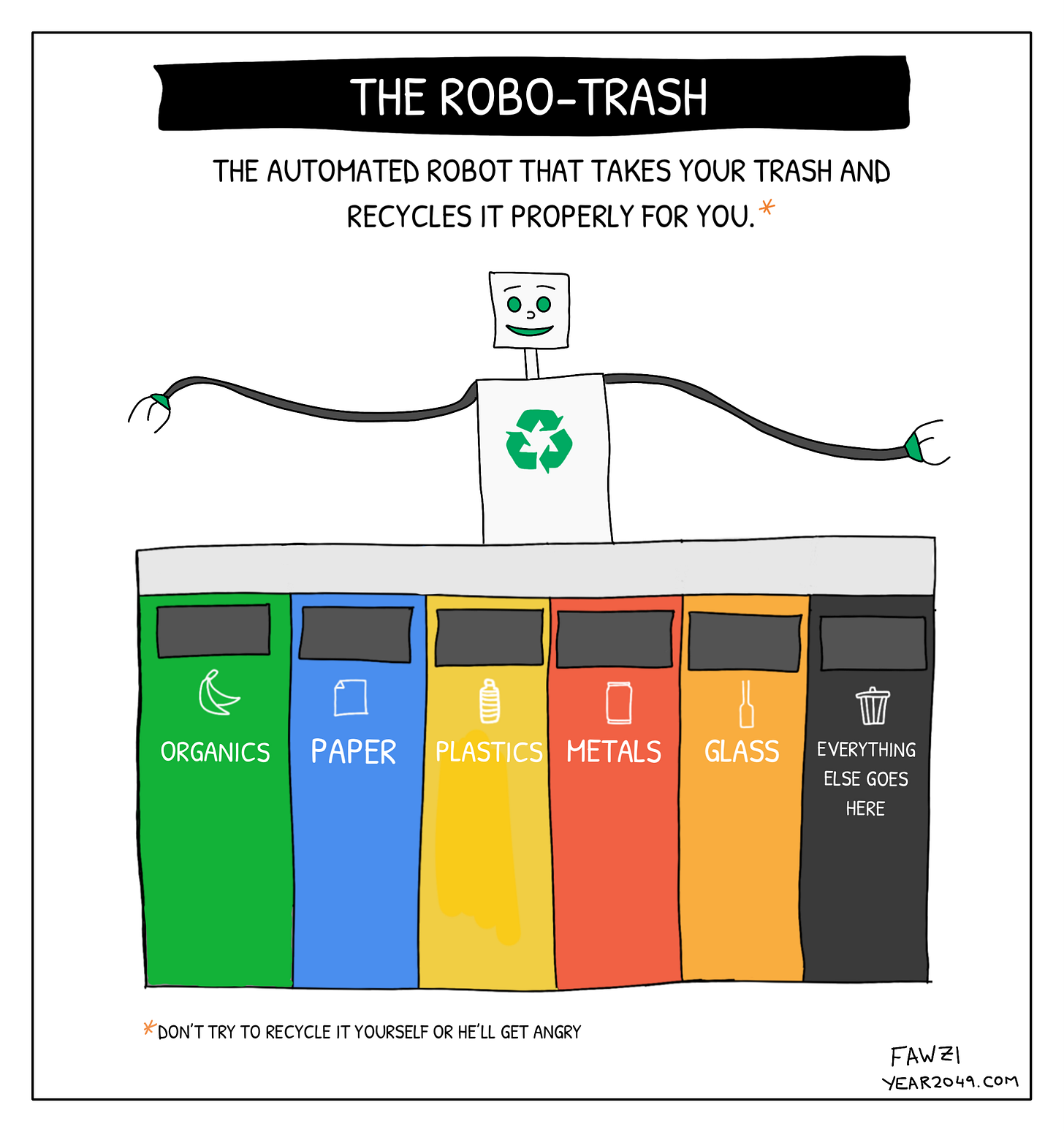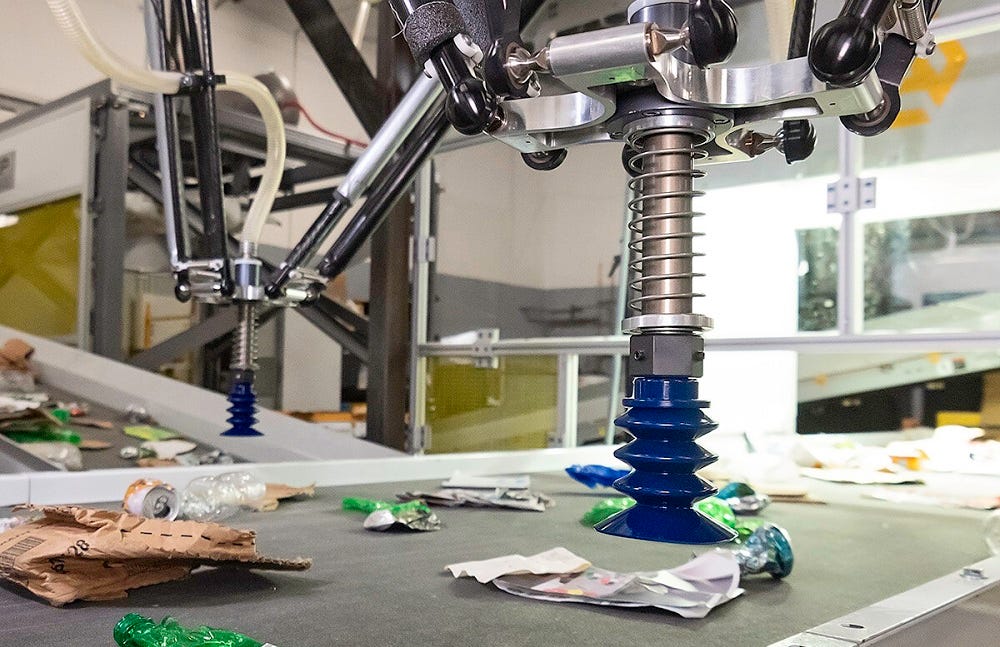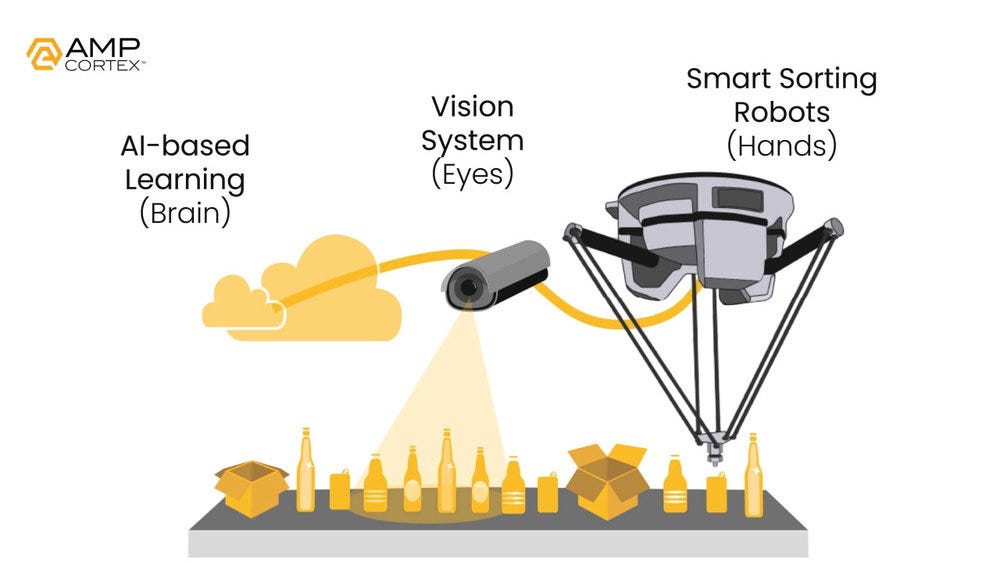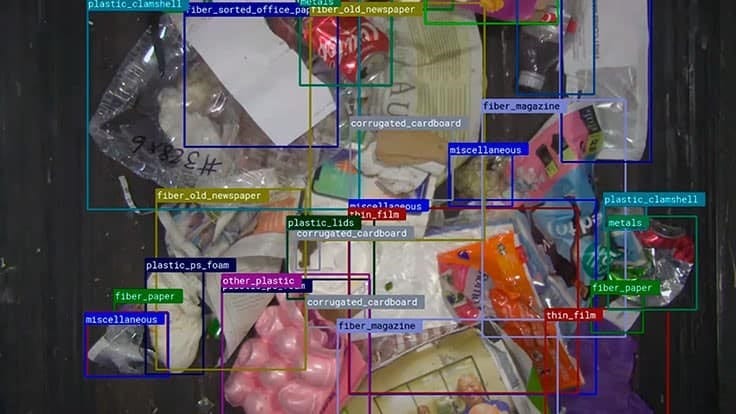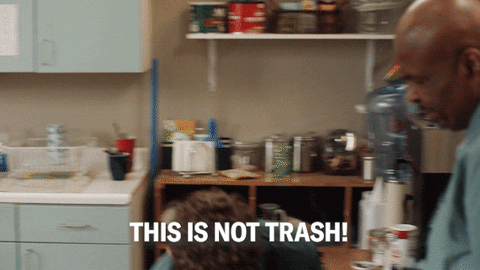AI + Robotics to improve our recycling systems ♻️
Examining AMP Robotics and existing problems with recycling
Year 2049 is the weekly newsletter that discusses the impactful innovations, discoveries, and research shaping our future.
If this was forwarded to you, subscribe for free to get a new story in your inbox every Friday.
Hello friends 👋
Recycling hasn’t lived up to its full potential, but that doesn’t mean we should give up on it. We just need to figure out different ways of improving all aspects of our recycling systems. Are AI and robotics up for the task? Let’s find out.
Read along and enjoy!
– Fawzi
Today’s Edition
Comic: the Robo-Trash
Story: AMP Robotics
Extra: The DeLorean EV
Quote: Doc Brown on the future
Comic
Story: AMP Robotics
The blue bin
Recycling can be a polarizing topic sometimes. Does it work? How much actually gets recycled? Why does plastic end up in landfills? Is it all just a PR stunt?
It’s fair to criticize recycling because it’s far from perfect. A recent OECD report sheds light on what happens with global plastic waste:
9% is recycled
19% is incinerated
50% ends up in landfills
22% evades waste management systems, is burned in open pits, or ends up in the environment
The numbers are disappointing, to say the least. But I don’t think we should abandon recycling. I see these inefficiencies as opportunities for improvement and innovation.
AMP Robotics wants to improve our recycling systems
Improving our recycling systems will get us closer to the circular economy we’re dreaming of.
This is what motivated Matanya Horowitz to start AMP Robotics back in 2015. The Colorado-based startup has raised $76.1 million in funding from the likes of Sequoia Captial and Google Ventures to help material recovery facilities (MRFs) optimize and improve their recycling processes.
With its expertise in AI and robotics, AMP wants to help businesses, governments, and NGOs accurately categorize, sort, and track different types of recyclables including:
Plastics: PET/PETE, HDPE, PVC, LDPE, PP, PS, and others
Paper: newspapers, magazines, cardboard, cartons, cups
Metals: aluminum, aerosol cans, foil, nonferrous food containers
Construction Materials: fibre, copper, gypsum, concrete, masonry, tile, wood
Electronics: batteries, brass, copper, wires, circuit boards
Organics
The company has already partnered and deployed its technology in North America and Europe:
North America: Partnered with Waste Connections and Evergreen to install its automated sorting systems at their facilities in the US and Canada. AMP also built its own recycling facilities in Denver, Atlanta, and Cleveland.
Europe: Partnered with Recyco in the UK and Ireland, and with FCC Medio Ambiente, a construction company, in Spain.
AMP’s technology
At a recycling facility, recyclables are placed on a conveyor belt and sorted by humans and machines. AMP aims to replicate and automate that process while improving speed and accuracy with its AI-powered solutions.
At the heart of AMP’s technology is their AI model which has been trained on over 50 billion images of containers and packaging types in real-world conditions. It can determine characteristics like the colour, size, material type, form factor (bottle, lids, cups), and brand of a recycled item.
The AI model powers a computer vision system that analyzes and categorizes items on the conveyor belt in real-time. Take a look at how it classifies each item in the image below:
Then, a robot picks up and sorts the items with up to 99% accuracy. It can pick 80 items per minute, almost twice as much as a human. 230 of these robots currently operate at 80 different facilities around the world.
Behind the scenes, human operators have access to a data platform that provides real-time analytics and insights into their recycling operation. This helps with quality control and identifying any issues in the process.
Beyond MRFs
When I think of recycling, I think of how products flow from companies to consumers to MRFs.
To unlock recycling’s full potential, it’s important to step back and look at the upstream problems in the recycling process. I like to look at them as separate design problems that need to be addressed:
For companies:
How can they reuse materials as much as possible?
How can they design packaging that is more easily recyclable?
For consumers:
How can we make it easier for people to recycle and avoid common recycling mistakes?
For MRFs:
How can they optimize and improve their recycling operation?
While AMP is focused on helping MRFs, I think they have the right technology to help companies and consumers too.
#1: Helping companies
What stood out to me about AMP’s AI model is its ability to identify the brand of a recycled item. If branded items can be sorted and grouped, it creates an opportunity for MRFs to sell back these recycled items directly to those companies. Instead of remaking tonnes of shampoo bottles, is there a way to sort, clean, and resell them to the same companies that manufactured them?
I realize this is an ambitious scenario. But I would be curious to see AMP Robotics partnering with a CPG company (like P&G or Unilever) and testing this approach at one of their facilities.
If this is possible, it’s a win-win for MRFs and companies:
MRFs would create a new revenue stream and use less energy to reprocess some recyclables.
Companies would reduce their raw material and production costs, with the added PR benefit of fully recovering and reusing their products.
#2: Helping consumers
Recycling can be confusing. It’s hard to remember what can be recycled and how it should be recycled.
A common problem in the recycling industry is “wishcycling”. This represents our common tendency to put items in the blue bin and hope they get recycled somehow. While it may feel harmless from our perspective, it creates additional work for MRFs to sort these items out of the valuable materials that can be recovered.
If AMP’s data platform can provide analytics and insights on items that are “wishcycled” or incorrectly recycled (e.g. contaminated), it can feed back into consumer education efforts led by local municipalities and businesses to prevent these items from reaching MRFs. Instead of generic messaging about recycling, it can be specific to the recycling mistakes that are common in that city or community.
Or, someone can fund my revolutionary Robo-Trash idea.
Final thoughts
Recycling won’t save the planet alone, but that doesn't mean that it’s useless. After all, we can agree that it’s better to recycle what we can than to have all our waste pile up in landfills or end up somewhere in the environment.
There’s so much room for innovation in packaging design, helping consumers recycle better, and helping MRFs improve their recycling operations. Luckily, many companies are tackling different aspects of this important problem.
I’m excited to see how AMP Robotics evolves and I hope they succeed in helping MRFs improve their recycling operations. I’ll make sure to provide any important updates about the company in future Year 2049 episodes.
Deep dive
If you enjoyed today’s story, I’ve compiled some additional links to satisfy your curiosity:
Plastics – Last Week Tonight with John Oliver (YouTube) – highly recommended
What Happens to Your Recycling After It's Collected? (YouTube)
AMP Robotics in action at FCC Medio Ambiente’s Madrid facility (YouTube)
ABC News - How robots could help solve the US recycling problem (YouTube)
Extra: The DeLorean EV
Finally. A valid reason to get my driver’s license.
DeLorean, the company behind the famous time machine/car from Back to the Future, revealed its Alpha 5 electric vehicle. The design is a modern twist on the DMC DeLorean from the 1980s.
The estimated specs: 300+ mi range, 100kWh battery, and a top speed of 155 mph. But you should try to keep it under 88 mph. 😉
Quote: Doc Brown on the future
Speaking of Back to the Future, I wanted to end today’s edition with my favourite Doc Brown line:
It means your future hasn’t been written yet. No one’s has. Your future is whatever you make it. So make it a good one!
– Doc Brown in Back to the Future III
Watch the scene here 👇
Previous episodes you might enjoy
🚗 The 6 levels of driving automation, simply explained
🌞 Solar Geoengineering: is the cure worse than the disease?
You can also check out all previous Year 2049 episodes to learn about other innovations shaping our future across all aspects of life.
How would you rate this week's edition?



